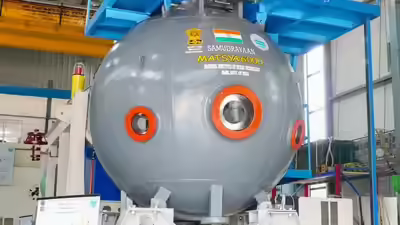Samudrayaan Project – India’s First Human-Crewed Deep-Sea Mission

Samudrayaan Project – India’s First Human-Crewed Deep-Sea Mission
Overview:
- Initiated by: Ministry of Earth Sciences (MoES) under the Deep Ocean Mission.
- Objective: Explore deep-sea biodiversity, mineral resources, and advance ocean technology to support India’s Blue Economy.
- Submersible Used: MATSYA 6000 – a specially designed human-occupied vehicle (HOV).
- Depth Target: 6,000 metres (≈3.7 miles).
- Crew Capacity: 3 scientists.
- Launch Timeline: Stepwise trials begin with 500 m tests in 2025; full mission expected by end of 2026.
Key Objectives:
- Manned Deep-Sea Exploration: Safely transport crew to extreme ocean depths using MATSYA 6000.
- Resource Survey: Explore polymetallic nodules rich in cobalt, nickel, manganese, and copper in the Central Indian Ocean Basin (75,000 sq km allocated to India).
- Marine Biodiversity Research: Study deep-sea flora and fauna, aiding conservation and scientific knowledge.
- Technological Advancement: Develop indigenous deep-sea engineering solutions, underwater robotics, and ocean observation technologies.
- Blue Economy Support: Promote sustainable use of ocean resources including mining, fisheries, and potential deep-sea tourism.
MATSYA 6000 Submersible – Features
- Structure: 2.1–2.26 m diameter titanium alloy personnel sphere (80 mm thick, withstands >600 bar pressure).
- Weight: 25 tonnes (4th generation vehicle).
- Life Support: Human Support and Safety System (HSSS) – 12 hours operational, 96 hours emergency endurance.
- Navigation & Communication: Acoustic positioning system, underwater acoustic telephone; robotic arms for sample collection; high-resolution cameras.
- Mobility: Ballast system and thrusters for controlled descent, ascent, and maneuvering.
- Power: High-density Lithium-Polymer batteries for propulsion and operations.
Technological Highlights
- Titanium Hull Welding: Achieved critical high-penetration welds for safety at extreme pressures.
- Indigenous Collaboration: Developed jointly by NIOT, ISRO, DRDO, and Indian industry partners.
- Training: Indian scientists trained on French submersible NAUTILE in the Atlantic Ocean for operational experience at 5,000 m depth.
Budget & Funding
- Allocated Budget: ₹600 crore (part of the ₹3,649.8 crore allocation for MoES in 2025–26).
- Purpose: Development of manned submersible, deep-sea mining systems, bioresource utilization, ocean survey technologies, and marine stations.
Significance
- Positions India among a select group of nations capable of manned deep-sea exploration.
- Unlocks access to strategic oceanic mineral resources for electronics and energy sectors.
- Boosts scientific research, oceanography, climate study, and future marine tourism potential.
- Supports sustainable development of the Blue Economy.
Updated - May 13, 2025 08:37 pm | HT